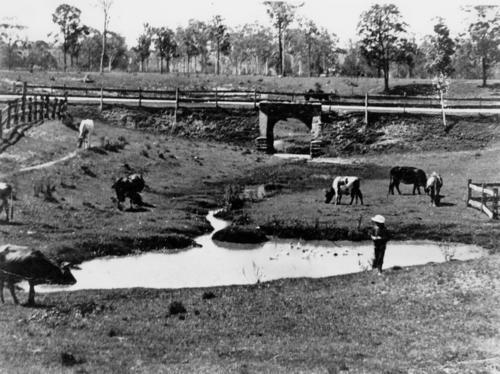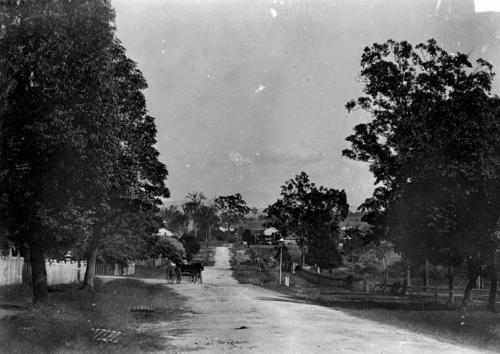Addresses
Type of place
House
Period
Federation 1890-1914
Style
Queenslander
Addresses
Type of place
House
Period
Federation 1890-1914
Style
Queenslander
This Federation style residence known as ‘Eboracum’ was built circa 1912-13 for Mary and Osborn Fenwick. During the Fenwick’s 30 year ownership the house became a social hub in the Wooloowin area, which was transitioning from rural agricultural use to closely-settled suburbia. Highly-intact, Eboracum is an excellent example of its type – a middle class villa and garden built in the Federation period.
Lot plan
L403_SP264597; L404_SP264597; L402_SP264597
Key dates
Local Heritage Place Since —
Date of Citation —
Construction
Roof: Terracotta tile;Walls: Timber
Criterion for listing
(A) Historical; (D) Representative; (E) AestheticInteractive mapping
Lot plan
L403_SP264597; L404_SP264597; L402_SP264597
Key dates
Local Heritage Place Since —
Date of Citation —
Construction
Roof: Terracotta tile;Walls: Timber
Criterion for listing
(A) Historical; (D) Representative; (E) AestheticInteractive mapping
History
This area formerly known as Eagle Junction was considered ripe for development after the opening of Eagle Farm Junction railway station in 1882. The ‘Thorrold Town Estate’, comprising twenty-eight acres (11.3ha) of land near the railway line, was offered for sale in sixteen perch (404m2) residential allotments shortly after the station opened. Quarry manager Thomas Melrose purchased large blocks of land in the area in the 1880s, including this site. The Melroses were amongst the suburb’s earliest residents, and at least two houses were built along Rose Street to accommodate the family.
In 1895 Thomas Melrose’s daughter Margaret Mary married Osborn James Fenwick, an Eagle Junction resident. The Fenwicks moved to Townsville, where Osborn partnered with Thomas Melrose junior (his brother-in-law) to form a monumental masonry company, Melrose and Fenwick. The firm, which had taken over Petrie and Sons’ Townsville branch, was later responsible for the work on a number of World War I memorials in north Queensland. Thomas Melrose junior went on to become Mayor of Townsville and Fenwick served as Deputy Mayor and Alderman of the Townsville City Council. After unsuccessfully standing in the seat of Kennedy in the Federal elections of 1909, Fenwick joined a political organisation, the Queensland People’s Progressive League (QPPL), and was appointed acting-secretary.
In December 1910 Melrose and Fenwick partnered with Brisbane monumental mason Downes, and Fenwick was transferred to manage the Brisbane office. He, Margaret and their four children moved into the Melrose family house ‘Roseleigh’, in anticipation of a new residence which would be constructed on a 48 perch (1,214m2) site in Rose Street, part of the Melrose family holding.
Despite its residential potential, highlighted by its proximity to Eagle Farm Junction railway station, Rose Street was still used as a cattle route in the 1910s. The Melrose family grazed its cattle in Melrose Paddock, directly across the road from the Fenwicks’ new property. By the time the Fenwicks arrived the street featured a combination of dairy farms, the creek-fed Melrose reserve, a joinery business and a small number of well-to-do residences largely constructed in the 1880s and 1890s, including ‘Coodra’, ‘Arran’ and Mrs Spencer Browne’s ‘Glenbar’.
Title to the Rose Street land was transferred to Margaret Fenwick from her brothers, inheritors of Thomas Melrose’s estate, in April 1912. The site stretched back to George Street (now Rawson Street) and had ample space for gardens and a tennis court. It was not a particularly well elevated site and a stream ran beside through the land but the installation of a stone drain in the land opposite improved drainage and reduced the risk of flooding. The Fenwicks’ house was erected by July 1913, when the Fenwicks took occupation. They named the residence ‘Eboracum’, an ancient Roman name for York. The house featured large verandahs and a tiled roof which reflected a fashion which had become popular in the early twentieth century.
In August 1912 Fenwick bought an additional 48 perches (1,214m2) of land to the east, adjoining Eboracum’s land across a small channel and slightly lower. He had a tennis court constructed here; whether this was built at the same time as the house is not known, but it was in place by 1924. A steep embankment was built to facilitate the flat court and a flight of stone steps were built to provide access from the house yard. It is possible that the stone was sourced from Fenwick’s work with Melrose and Fenwick.
In Queensland, tennis was a widely-accessible sport, contrary to the perception of it as a game for the wealthy upper class. The game was introduced to Queensland in the 1870s and became particularly popular after the 1888 formation of the Queensland Lawn Tennis Association. Courts were built in parks, church grounds and public land from the 1900s, allowing access for a wide variety of players. Middle class citizens who could afford to do so built tennis courts on their properties, hosting friendly matches and tournaments for neighbours and visitors. In Brisbane, the Suburban Lawn Tennis Association held cross-town fixture matches from the 1910s to the 1930s, hosted mostly on church and private courts. The association became so large
that it was split into four grades. The Fenwicks formed a second grade team called Eboracum and participated in the tournament in the mid-1920s.
Land values in Rose Street increased in the year following Eboracum’s construction, as Fenwick testified in 1917, with more land subdivision, sales and occupation. Services were installed including drainage, a post box and electric lighting. Melrose Paddock became a public recreation ground, with sports playing fields and courts laid out in the 1910s and 1920s.
Fenwick became involved in the local community almost immediately after moving to the area. He was one of the inaugural members of the Wooloowin Progress Association (formed in 1911) and joined the Windsor Branch of the QPPL. He resigned from his position in the QPPL to contest the seat of Brisbane for the Queensland Liberal Association (QLA) at the 1912 Federal election. He was unsuccessful at the election but afterwards became the general secretary of the QLA. The family also became known for their academic success. Fenwick’s daughter Marjorie won the Lilley Memorial Medal in 1914 and son Osborn Thomas was ranked third in Queensland in the 1918 scholarship exam. Both attended Eagle Junction State School in nearby Clayfield.
Although Fenwick retained his interest in Melrose and Fenwick, he abruptly changed his career in 1915 by opening the Imperial Picture Palace at Lutwyche, with a branch at Nundah two years later. He served as president of the Queensland Motion Picture Exhibitors’ Association in 1917, and was later a member, treasurer and president of the Exhibitions Cooperative Film Insurance Board of Queensland.
Eboracum became a social gathering place for those involved in the fledgling film industry throughout the 1920s. The Eboracum tennis courts were a particular focal point. Visiting American silent movie star Pauline Fredericks was amongst the spectators of a promotional match held between film exhibitors and the film exchange at the ‘picturesque residence’ in 1925.1 The match was filmed for posterity, though the film has not been uncovered.
Margaret Fenwick died in 1929 and Eboracum was transferred to her husband. In 1931 Fenwick transferred the tennis court and grounds of 57 Rose Street to his daughters Marjorie and Dorothy. A house was built for them on the site later that year. A 1931 newspaper article regarded Wooloowin as ‘a suburb of pleasant prospects, and the average homemaker has regarded it as a desirable, peaceful locality, which has the advantages of a frequent train service and convenient transit by trams… It is clean and open, and the gardens and lawns about the terraces of the houses compare favourably with the best in Brisbane.’2
Fenwick hosted few social functions at Eboracum through the 1930s and 1940s. He focused instead on the theatre, where he had introduced sound in 1929, and held events, fundraisers and appeals including an aluminium drive in World War II. He and his new wife, Hannah Terkelsen, resided at Eboracum until the 1940s when Fenwick retired and moved to Ascot.
Eboracum was sold out of the Fenwick family in 1943, to new owners who held the house until 2016, when it was transferred to new owners, only the third in more than 100 years. 57 Rose Street was owned by Dorothy Fenwick until 1972.
Description
Eboracum is a large house and grounds (1,164m2) fronting Rose Street, Wooloowin, standing impressively elevated from the street. It is a high-set timber-framed and -clad structure in a cohesive Federation style with a dominant roof clad with terracotta Marseilles tiles. The core of the house is encircled by a broad verandah with a variety of decorative timber detailing including heavy sweeping brackets, dowel balustrade, and moulding. The front of the house is symmetrically-composed with a broad timber stair providing access up to the verandah under a projecting gable.
The house is highly intact. It retains moulded timber joinery; a traditional layout with central hallway providing access to rooms either side; an expressive timber arch between the principal living rooms; large double-hung step-through front windows; French doors; and an unusually extensive use of decorative pressed metal ceilings in a range of patterns.
The yard retains brick garden walls with moulded brick copings framing the driveway and front rendered stair. Mature palms and other trees, garden beds, and grassed berms indicate the early garden layout. A small brick structure with a timber-framed gable roof stands at the rear of the house. A steep flight of stone steps with short side walls leads down from the house yard into what was the tennis court (no longer extant) but is now the yard of neighbouring 57 Rose Street. The stone is rock faced with clear pick marks.
Statement of significance
Relevant assessment criteria
This is a place of local heritage significance and meets one or more of the local heritage criteria under the Heritage planning scheme policy of the Brisbane City Plan 2014. It is significant because:
Supporting images

‘Cows grazing at Eagle Junction, Brisbane, Queensland, ca. 1910’ (JOL, SLQ, image number 35737) (Rose Street, Melrose Park. The site of Eboracum is to the right of the photo image.)

‘Driving cattle along Rose Street, Eagle Junction, Brisbane, Queensland, ca. 1910’ (Picture Queensland, JOL, SLQ, image number 37542)

‘Rose Street, Eagle Junction, Brisbane, Queensland, circa 1912’ (JOL, SLQ, image number 5781, George Mewes collection)

Daily Standard, Thursday 21 July 1927 p6
References
-
Telegraph 25 September 1925 p7
-
Brisbane Courier 4 April 1931 p17
-
Brisbane City Council aerial photographs, 1946, 2012
-
Brisbane City Council Heritage Unit Files
-
Brisbane City Council Heritage Unit, Clayfield/Wooloowin Character and Heritage Study, July 1997
-
Brisbane City Council, Properties on the Web, website
-
Brisbane City Council Sewerage Detail Plans
-
Department of Natural Resources and Mines, Queensland Certificates of Title
-
Howell, Maxwell L, The genesis of sport in Queensland: from the dreamtime to federation, St Lucia: UQ Press, 1992
-
Mackenzie, Marion, ‘Promising Lives: First placegetters in the Queensland Scholarship Examination 1873-1962’, PhD thesis, University of Queensland, 2006 (via Text Queensland)
-
McCallum, Beres, A Walk Through the history of Thorroldtown and Maida Hill, Wooloowin, 30 July 2000 and A Walk through the history of Thorroldtown: Part 2 of the Thorroldtown Story, Wooloowin, 29 July 2001’, Windsor: Windsor and Districts Historical Society, 2001
-
McKellar's Map of Brisbane and Suburbs. Brisbane: Surveyor-General’s Office, 1895
-
National Library of Australia, Trove newspapers, Brisbane Courier, Courier Mail, Cairns Post, Examiner, Telegraph, Mercury, Daily Standard, Townsville Daily Bulletin, Northern Miner, The Week
-
State Library of Queensland, Picture Queensland
-
Queensland Births, Deaths and Marriages
-
Queensland Post Office Directories
-
Queensland State Archives, Assisted immigration records
-
RP Data, photos
-
State Library of Queensland, estate maps
-
Text Queensland
Citation prepared by — Brisbane City Council (page revised September 2020)